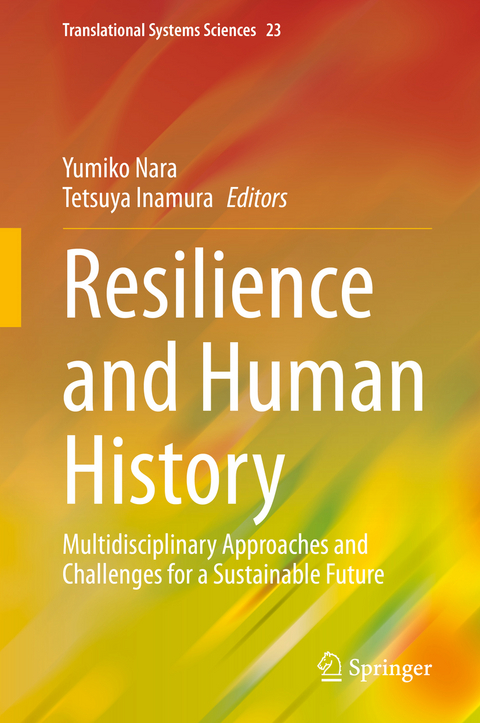
Resilience and Human History
Springer Verlag, Singapore
978-981-15-4090-5 (ISBN)
The term "resilience" was originally used in psychology, but in current-day usage, it mainly refers to the "ability to recover from disaster"; however, the concept of resilience is still ambiguous. This book challenges readers to reconsider the concept of resilience comprehensively from diverse perspectives and to re-conceptualize it as an important framework applicable in various research fields.
The book explores resilience by expanding the time and space scales to the maximum. On the time axis, it traces back to our human ancestors (and even to anthropoid apes) and follows the evolution of humans, the origin of agriculture, the rise and fall of ancient civilizations, and the present day. On the space axis, it discusses levels ranging from genetic; bacterial flora; individual, indigenous communities; and modern societies; to the global level. As such it expands the base for considering the problems facing modern society and selecting a future direction.
In the long history of evolution, we Homo sapiens have faced, and overcome, various kinds of risks. By acquiring resilience, we have surpassed other animals and become apparent rulers of the earth; but, at the same time, we are also facing more serious risks than ever before. This book provides insights into addressing the challenges of a sustainable future.
Yumiko NARA is a Professor in the Human Life and Health Sciences Program, The Open University of Japan. She holds a Ph.D. degree from Nara Women’s University. Her research interests include community-based disaster risk management, and risk communication related to science and technology. She works closely with local communities and citizens, using qualitative and quantitative research methods based on systems approaches. She was awarded a prize by the Japan Risk Management Society. She has been a member of the Investigation Committee specializing in Research and Development Strategy at the National Center of Incident Readiness and Strategy for Cybersecurity in the Cabinet Secretariat, and the Committee on Safety, Security, Science and Technology at the Ministry of Education, Culture, Sports, Science and Technology, Japan. Tetsuya INAMURA is a specially appointed Professor in the Humanities Program at the Open University of Japan. He holds amaster’s degree in Sociology from the University of Tokyo. He joined the Open Field Museum “Little World” as a researcher and was involved in the foundation of the museum. He also worked as an Associate Professor and Professor at Aichi Prefectural University before moving to his current position. He is a cooperative member of the Science Council of Japan. His major academic interests are museology and cultural anthropology, and research on pastoral cultures in the Andes, the Himalayas, and Mongolia.
Chapter 1. Resilient Features which Humans Inherited from Common Ancestors with Great Apes and Strengthened.- Chapter 2. Using Genetics to Understanding the Evolution of Human Resilience.- Chapter 3.Individual Differences in Psychological Resilience.- Chapter 4. Human Evolution and the Implication of Resilience for the Future.- Chapter 5. Pastoral Nomadization in the Neolithic Near East: Review from the Viewpoint of Social Resilience.- Chapter 6. Infectious Diseases: Conquest or Co-existence?.- Chapter 7. Resilience in the Andes: Ancient Civilization and Indigenous Society.- Chapter 8. Resilience amongst Nomads and Urban Residents in Mongolia’s Transition to a Market Economy.- Chapter 9. Dynamic Resilience of Ayta community: Creative Rehabilitation after Mt. Pinatubo Eruption 1991.- Chapter 10. Resilience of Life (Livelihood) and Natural Disasters.- Chapter 11. The Essence of Resilience against Disaster: Requirements for Geographic Education.- Chapter 12. Common Features of BusinessResilience in Japanese Companies.- Chapter 13. Resilience of Earth System.- Chapter 14. Concluding chapter: What is “Resilience”?.
| Erscheinungsdatum | 04.09.2020 |
|---|---|
| Reihe/Serie | Translational Systems Sciences ; 23 |
| Zusatzinfo | 44 Illustrations, color; 30 Illustrations, black and white; X, 221 p. 74 illus., 44 illus. in color. |
| Verlagsort | Singapore |
| Sprache | englisch |
| Maße | 155 x 235 mm |
| Themenwelt | Sozialwissenschaften ► Pädagogik ► Sozialpädagogik |
| Sozialwissenschaften ► Politik / Verwaltung ► Staat / Verwaltung | |
| Sozialwissenschaften ► Soziologie ► Spezielle Soziologien | |
| Wirtschaft ► Betriebswirtschaft / Management ► Unternehmensführung / Management | |
| Wirtschaft ► Volkswirtschaftslehre ► Wirtschaftspolitik | |
| ISBN-10 | 981-15-4090-X / 981154090X |
| ISBN-13 | 978-981-15-4090-5 / 9789811540905 |
| Zustand | Neuware |
| Haben Sie eine Frage zum Produkt? |
aus dem Bereich


